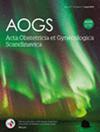Impact of levator ani muscle avulsions on Manchester procedure outcomes: A 5-year follow-up study
Abstract
Introduction
Levator ani muscle avulsion is a risk factor for inferior outcomes after native tissue pelvic organ prolapse repair. In a previously published study, we found no such association 1 year after the Manchester procedure (anterior repair combined with cardinal and uterosacral ligament suspension and perineal repair). The aim of the present study was to compare women with and without levator ani muscle avulsions in terms of patient-reported and anatomical outcomes, and failure rates in the same cohort after 5 years.
Material and Methods
Five-year prospective cohort study of 143 women operated on for anterior and/or mid-compartment pelvic organ prolapse with the Manchester procedure between October 2014 and January 2017, Clinical Trial study number NCT02246387. Levator ani muscle avulsions (uni- or bilateral) were diagnosed at inclusion by transperineal ultrasound. Primary outcome at 5-year follow-up was subjective bulge symptoms (question 3, Pelvic Floor Distress Inventory-20). Secondary outcomes were total score from the same questionnaire, sexual distress (Pelvic Organ Prolapse/Urinary Incontinence Sexual Questionnaire-12), subjective cure, Pelvic Organ Prolapse Quantification scale measurements, defining optimal outcomes as anterior compartment stage <0–1 and mid-compartment point C ≤−5, and new surgical or conservative prolapse treatment.
Results
Among 143 women followed up after 5 years, the avulsion rate was 52.4%. Both groups showed similar reductions in bulge symptoms, pelvic floor symptoms, and anatomical anterior- and mid-compartment measurements. Sexual distress improvement was significantly greater for women with avulsion (Mean change difference: −3.4 (−6.4 to −0.5)). Multivariate regression revealed no significant effect of avulsion on symptom scores, cure rates, or need for new prolapse treatment. Women with avulsion had half the odds of obtaining an optimal anterior compartment outcome compared to those without avulsion (adjusted odds ratio: 0.5 (0.2–0.9)).
Conclusions
Although women with levator ani muscle avulsion had lower odds of achieving an optimal anterior compartment outcome, the overall anatomical changes from preoperative to 5 years were similar in both groups. Importantly, avulsion did not impact symptom improvement, patient-reported outcomes, or the need for further treatment. These findings support the Manchester procedure as an effective and durable surgical option for women with POP, regardless of avulsion status.


 求助内容:
求助内容: 应助结果提醒方式:
应助结果提醒方式:


